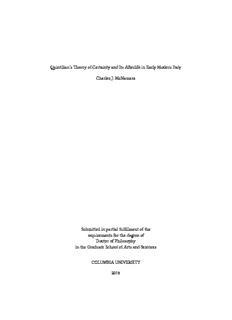
Quintilian's Theory of Certainty and Its Afterlife in Early Modern Italy Charles J. McNamara ... PDF
Preview Quintilian's Theory of Certainty and Its Afterlife in Early Modern Italy Charles J. McNamara ...
Quintilian’sTheoryofCertaintyandItsAfterlifeinEarlyModernItaly CharlesJ.McNamara Submittedinpartialfulfillmentofthe requirementsforthedegreeof DoctorofPhilosophy intheGraduateSchoolofArtsandSciences COLUMBIAUNIVERSITY 2016 ©2016 CharlesJ.McNamara Allrightsreserved ABSTRACT Quintilian’sTheoryofCertaintyandItsAfterlifeinEarlyModernItaly CharlesJ.McNamara Thisdissertationexploreshowantiquityandsomeofitsearlymodernadmirersunder- standthenotionofcertainty,especiallyasitistheorizedinQuintilian’sInstitutioOratoria, a first-century educational manual for the aspiring orator that defines certainty in terms ofconsensus. Aspartofalargerdiscussionofargumentativestrategies,Quintilianturns to the “nature of all arguments,” which he defines as “reasoning which lends credence to what is doubtful by means of what is certain” (ratio per ea quae certa sunt fidem dubiis adferens: quaenaturaestomniumargumentorum,V.10.8). Thesecertainties,helaterspec- ifies,includenotmattersofscientificdemonstrationorobjectivefact,buttheagreements of various communities: the laws of cities, local customs, and other forms of consensus. As the foundation of persuasive rhetoric, these consensus-based certainties situate ar- gumentationasthepracticeofcraftingagreementsratherthandemonstratingnecessary conclusions. Taking as its point of departure Quintilian’s novel understanding of certainty, this study looks to some of Quintilian’s intellectual forebears as well as his later readers to show how his work is both a nexus of earlier intellectual developments as well as an important inspiration for later accounts of certainty, even into the early modern period. After illustrating in the first chapters of this dissertation how Quintilian’s manual incor- porates elements from Aristotelian notions of dialectic and rhetoric as well as from Ci- ceronian skeptical approaches to epistemology, I show how Quintilian’s curriculum for theoratorshapesthethoughtofItalianhumanists,especiallythatofLorenzoValla(1406– 1457), a reformer of scholastic logic and dialectic, and Giambattista Vico (1668–1744), an influential Neapolitan jurist. Adopting Quintilian’s rendering of certainty as a matter of agreements and conventions, these later authors elaborate their own novel approaches to various fields—including law, language, and logic—through this ancient understand- ing of certum. Contrary to modern notions of certainty as objective or scientific fact, Quintilian’shumanistreaderscontinuetorootthisconceptinconsensus,bothwithinthe courtroomandwithout. Contents Acknowledgments ii Introduction 1 1 Aristotle’sEnthymemeandtheRoleofAgreementinRhetoric 13 2 SkepticismandPropertyinCiceronianCertainty 55 3 TheStatusofSkepticisminQuintilian’sTheoryofCertainty 89 4 CertumatqueConfessum: VallaontheForensicsofCertainty 118 5 AVichianCoda: TheEndofHumanistCertainty 143 Conclusion 174 Bibliography 179 i Acknowledgments My utmost gratitude goes to Kathy Eden, not only for her careful and generously given academicadvicewhileIwrotethisdissertationbutalsoforheryearsofintellectualfriend- ship during my graduate education. I thank also Katja Vogt for her insightful guidance fromtheearlieststagesofmyresearchandthroughitsfinalrevisions. Theothermembers ofmycommittee—GarethWilliams,ElliotPaul,andMatthewMcGowan—deservethanks fortheirattentivereadingofmyworkandtheirthoughtfulsuggestionsforimprovingit. I am grateful to Elizabeth Irwin and Elizabeth Scharffenberger, too, for facilitating my researchandteachingwhileIwrotethisdissertation. Special thanks is due to Joe Sheppard, who read parts of this dissertation and offered helpful suggestions for both style and argument. Molly Allen, Kate Brassel, Claire Cate- naccio,andMathiasHansesallprovidedcrucialmoralsupportascompatriotswhileteach- inginColumbia’sCoreCurriculumoverthepasttwoyears. AndCalebDance,alimitless sourceofcomicfraternity,canneverbethankedsufficientlyforhiscompanionshipduring mygraduatestudies. Several others among the graduate students at Columbia have been helpful while working on this project: Colin, James, Zoë, Sarah, Sam, and others have provided in- dispensablelevityandintellectualstimulationovertheseseveralyears. ii My parents, Michael and Beverly, have my eternal gratitude not only for support- ing my many years of education but also for modeling the joys of learning and reading throughoutmylife. MybrotherJohn,too,hasbeenamuch-neededsourceoflaughter,as havemyauntMaryLizanduncleRick. Finally, I thank all my students. From my English students at Central High School inHelena-WestHelena,Arkansas,tomysophomoreinterlocutorsinContemporaryCiv- ilization at Columbia, the inquisitive minds in my classroom have always propelled my ownstudies. Tothem,Iwillalwaysbegrateful. iii FormygrandmotherMaureen, whotaughtmetolovewords iv Introduction In his 1689 An Essay Concerning Human Understanding, the English philosopher John Lockeinsiststhat“thehighestprobability,amountsnottocertainty;withoutwhich,there can be no true knowledge.”¹ At least for Locke and his like-minded contemporaries, the notion of certainty is identified with unassailable knowledge: what is certain is invari- ableandassured. AndasLockeexplainslaterinhisessay,hisunderstandingofcertainty extends to matters within ethics and politics as well as to other matters, for he insists that “moral knowledge is as capable of real certainty, as mathematics.”² This notion of certainty in the English language as empirically verified knowledge persists throughout the thinking and writing of later philosophers as well, a tradition that continues within contemporarydiscussionsofscienceandpoliticsalike. FromBenjaminFranklin’smaxim that “nothing can be said to be certain, except death and taxes” to Werner Heisenberg’s contributions to quantum physics, in which “uncertainty” points to the instability and imprecision of laboratory measurements, the status of certainty in modern English in- tellectual discourse—whether in matters of taxes or physics—is closely tied to notions of predictability,immutability,andso-calledscientificobjectivity. ¹IV.12. CitationsofAnEssayConcerningHumanUnderstanding aretakenfromKennethWin- kler,ed. (Indianapolis: Hackett,1996). ²IV.7. 1 But this notion of certainty—what is certum—has not always carried this valence of stable,objectiveknowledge,especiallyasitwasunderstoodbytheRomanrhetoricaltra- dition. While empiricist reformers of the seventeenth century like Locke will claim that “impartiality [should be] expected of judges as much as of scientists,” several earlier au- thorsviewtherhetoricalcertaintyoftheancientoratorandthedemonstrativecertaintyof themodernphysicistasessentiallyseparatecategoriesofknowledge.³ Particularlywithin oneinfluentialthreadofrhetoricalthinking,theancientunderstandingofcertaintydoes not point to unimpeachable fact but instead toward matters of consensus. This more un- stableconceptualizationofcertaintylikelymotivatesFrancisBacon’sremarksinhis1605 Advancement of Learning that caution, “if a man will begin with certainties, he shall end indoubts.”⁴ OnlyafewdecadesbeforeLockewritesofhisutmostconfidenceintheepis- temicvalueofcertaintyas“trueknowledge,”Baconshowsananxietyaboutitsreliability forgroundingscientificdiscovery. While Bacon cautions against using certainties as the foundation for proofs, one prominent tradition within ancient rhetorical thought advocates for certainty’s indis- pensable role in argumentation. At the center of this tradition sits Quintilian’s Institutio Oratoria, a first-century rhetorical manual whose twelve books aim to educate the ideal rhetorician: the “good man skilled in speaking.”⁵ As part of a larger discussion of the natureofrhetoricalproof,adiscussionthatstarklycontrastswithBacon’swarningabout ³Shapiro(1983,p.190). ⁴V.8. Citations of Francis Bacon are taken from The Works of Francis Bacon, James Spedding, RobertLeslieEllis,andDouglasDenonHeath,eds. (NewYork: GarrettPress,1968). ⁵Sit ergo nobis orator quem constituimus is qui a M. Catone finitur vir bonus dicendi peritus, XII.1.1. Translations of Quintilian’s Institutio Oratoria are adapted from D.A. Russell, ed. and trans. (Cambridge,MA:HarvardUniversityPress,2001). 2
Description: